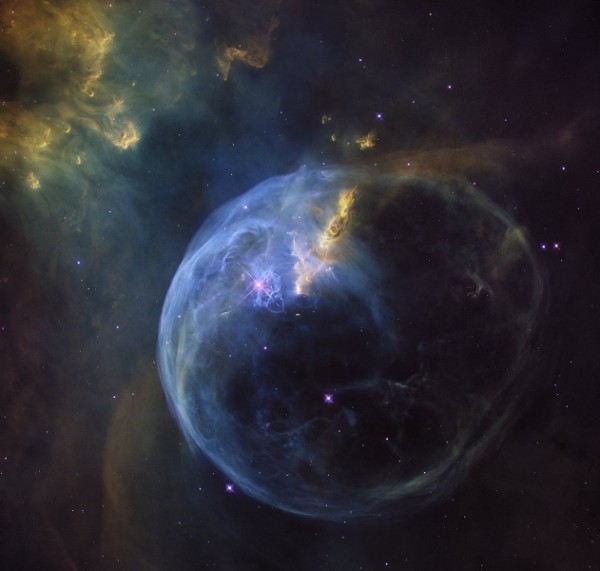By Ana Verayo, | April 22, 2016

The Bubble Nebula, also known as NGC 7635, is an emission nebula located 8 000 light-years away. This stunning new image was observed by the NASA/ESA Hubble Space Telescope to celebrate its 26th year in space.
The Hubble Space Telescope now marks its 26th year in space, and to celebrate its birthday, NASA shared this stunning, cosmic blue bubble portrait of the "Bubble Nebula".
Located some 8,000 years away in the constellation Cassiopia, this is not the first time that the Hubble Space Telescope has observed this glowing translucent, iridescence floating in deep space, where the telescope only captured close up parts of the nebula due to its massive size. Now, this new image was taken from 4 separate images and completing it into one composite image using Hubble's Wide Field Camera 3 (WFC3), turning it into a mosaic, to create a colossal glowing, sparkling azure stellar bubble for the first time ever.
Like Us on Facebook
At first glance, the Bubble Nebula may have been an explosive stellar aftermath from a massive supernova. However, its globular, tenuous sparkling appearance weaved by powerful stellar winds originating from a star, created an almost perfect bubble shape.
The star responsible for the Bubble Nebula is known as SAO 20575 which can be viewed at the left part from the center of the bubble. The star is also enshrouded in gas and dust like a nucleus of the nebula itself, where this molecular cloud serves as some sort of stellar nursery, churning out new, hot stars.
Due to the presence of SAO 20575, it generates massive stellar winds that blast through this molecular cloud, pushing gas and dust away from the star, finally forming this bright and opalescent bubble. The size of this dazzling bubble is about 10 light years across, which is twice the distance of the sun between the nearest star system Alpha Centauri, where stellar winds are gusting at 100,000 kilometers per hour.
This massive bubble still continues to expand due to this powerful hurricane that pierces through this stellar molecular cloud. Prior observations from Hubble reveal smaller concentrations of gas and dust twisted in the middle of this howling stellar winds, which is about the size of Earth.
The Hubble Space Telescope was launched via NASA's space shuttle Discovery last April 24, 1990, revealing unprecedented images of our galaxy and beyond, still producing new and crucial scientific discoveries.
-
Use of Coronavirus Pandemic Drones Raises Privacy Concerns: Drones Spread Fear, Local Officials Say

-
Coronavirus Hampers The Delivery Of Lockheed Martin F-35 Stealth Fighters For 2020

-
Instagram Speeds Up Plans to Add Account Memorialization Feature Due to COVID-19 Deaths

-
NASA: Perseverance Plans to Bring 'Mars Rock' to Earth in 2031

-
600 Dead And 3,000 In The Hospital as Iranians Believed Drinking High-Concentrations of Alcohol Can Cure The Coronavirus

-
600 Dead And 3,000 In The Hospital as Iranians Believed Drinking High-Concentrations of Alcohol Can Cure The Coronavirus

-
COVID-19: Doctors, Nurses Use Virtual Reality to Learn New Skills in Treating Coronavirus Patients







